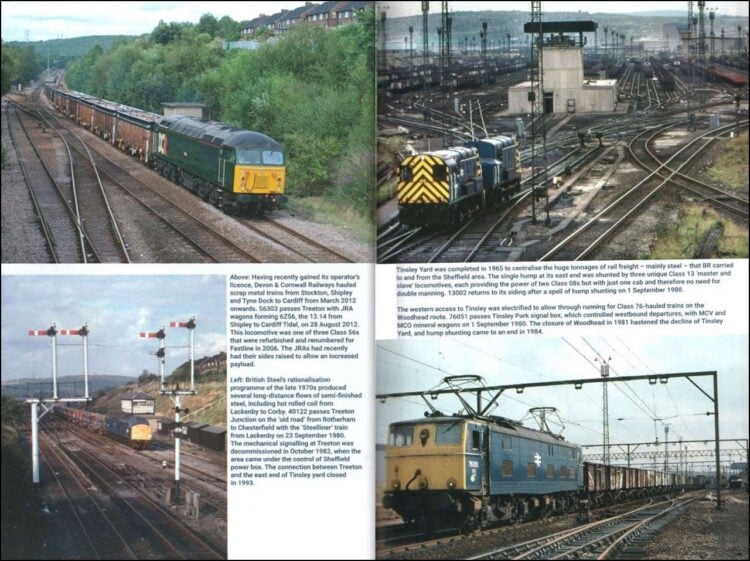This book illustrates the changing pattern of freight traffic on the railways of Yorkshire and North East England during the last 40 years.
Published in November 2022 by Key Publishing and written by Paul Shannon, this soft cover book is book No. 7 in the publisher's Railways and Industry Series.
It measures around 24.2 cm x 17.2 cm, has 96 pages and 177 illustrations and a published price of £15.99 from Key Publishing, but is available from Amazon for £12.75.
The book is logically divided into chapters, starting with the area around Sheffield, then working north through the Doncaster area; Wath, Healey Mills, and the Pennine crossing; Leeds, Bradford, and Skipton; Wakefield and the Aire Valley; Goole and Hull; Selby and York; Teesside and the Redmire Branch; County Durham; Tyne and Wear; and Blyth and Tyne.
The area covered by this book has seen more change in patterns of freight traffic than anywhere else in Britain. Gone are the Classes 25 and 40, the Class 76s on the Woodhead route, and Class 13 ‘master and slave' shunters at Tinsley yard in Sheffield. Class 37s still see occasional use, but freight traffic today is dominated by Class 60s and 66s, although their uniformity is relieved by a number of different owners and livery styles.
Through the pages of this book the author brings to life the changing patterns of freight in the area. From the decline in the coal industry, the steel industry around Sheffield, and the iron ore trains from Tyne Dock to Consett, although Tyne Dock continues to be an important rail site as it is now a terminal for importing biomass. The photographs illustrate how the make up of trains has changed, with block trains of oil tankers and other products now replacing the endless coal trains that were such a familiar scene 40 years ago.
Although there are relatively few classes of trains to be seen these days, that lack of variety is compensated for by different operators, some of whom have given a new lease of life to previously withdrawn locomotives. One such example is seen at the top left below, where a Devon & Cornwall Railways Class 56 No. 56303 is hauling a load of scrap metal. On the right is a scene that has been consigned to history, with at the top the former hump marshalling yard at Tinsley in Sheffield with one of three unique Class 13 ‘master and slave' shunters. At the bottom is a memory of the line that should never have been closed, the Woodhead route through the Pennines, with one of the Class 76 electric locos that were built specially for use on the route.

At the eastern end of the Woodhead route was Wath marshalling yard where Class 76s that had hauled trains through the Pennines gave way to diesel haulage. The captions to these photos are typical of the rest of this book, where as well as giving the usual, what, where, and when information, the author has included additional useful information.
The photos below illustrate how freight traffic in the area covered by this book has changed. The top-left photo shows a train of biomass pellets for Drax power station, which just a few years ago would have been a train load of coal. At the bottom left is a scene to make many a Yorkshireman shudder, as it shows imported coal being loaded at Hull Docks.
At the top left below is yet another memory, as it shows a scene at the former steelworks at Redcar, which closed in 2015. The other photos on these pages are typical of the change in traffic over the last 40 years, with at the bottom left a train of potash from a potash mine near Whitby, and at the bottom right is a train of fuel tanks.
Although in the 1980s coal trains were the ‘bread and butter' for freight traffic in Yorkshire and the northeast, the book contains relatively few views of such trains. Two such trains are seen below.at Plawsworth in County Durham.
In the 40 years covered by this book, the railway scene in Yorkshire and northeast England has changed quite dramatically, with changes in liveries, motive power, and the nature of freight traffic. The author's selection of photographs shows just how much has changed. Perhaps one of the major changes has been the decimation of the coal industry, with coal now being imported and the large power station at Drax being fuelled by Biomass.
The endless stream of coal trains are now but a memory, and should serve as a message that we should record that what we consider to be familiar today, may, in a few years' time, be consigned to history. With coal being such an important feature of the area's freight traffic until relatively-recently, I would have expected to see more photographs of coal trains.
The photograph captions are well-written and fully detailed, with useful additional information.
The book is available to purchase from Amazon and from Key Publishing.
We would like to thank Key Publishing for providing us with a copy of the book for review.